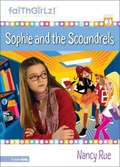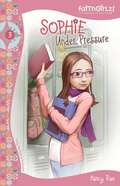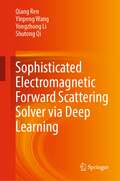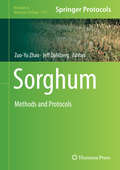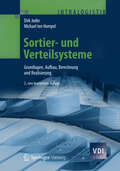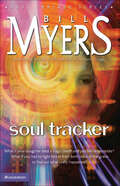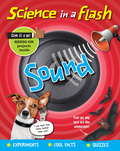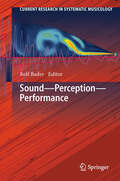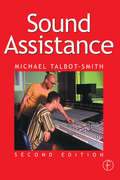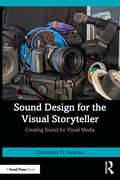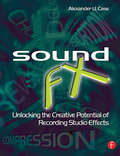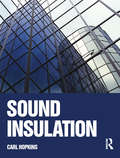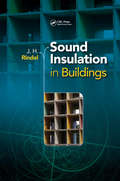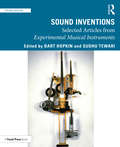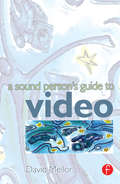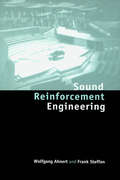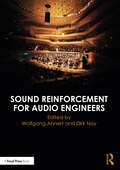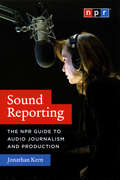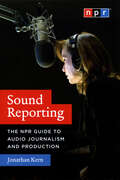- Table View
- List View
Sophie and the Scoundrels
by Nancy RueWorried that her parents are breaking up, Sophie gets lost in an imaginary world again as she and her friends transform Fiona's tree house into a space station as a school science project, despite sabotage and jealousies.
Sophie under Pressure
by Nancy RueWorried that her parents are breaking up, Sophie gets lost in an imaginary world again as she and her friends transform Fiona's tree house into a space station as a school science project, despite sabotage and jealousies.
Sophisticated Electromagnetic Forward Scattering Solver via Deep Learning
by Qiang Ren Yinpeng Wang Yongzhong Li Shutong QiThis book investigates in detail the deep learning (DL) techniques in electromagnetic (EM) near-field scattering problems, assessing its potential to replace traditional numerical solvers in real-time forecast scenarios. Studies on EM scattering problems have attracted researchers in various fields, such as antenna design, geophysical exploration and remote sensing. Pursuing a holistic perspective, the book introduces the whole workflow in utilizing the DL framework to solve the scattering problems. To achieve precise approximation, medium-scale data sets are sufficient in training the proposed model. As a result, the fully trained framework can realize three orders of magnitude faster than the conventional FDFD solver. It is worth noting that the 2D and 3D scatterers in the scheme can be either lossless medium or metal, allowing the model to be more applicable. This book is intended for graduate students who are interested in deep learning with computational electromagnetics, professional practitioners working on EM scattering, or other corresponding researchers.
Sorghum in the 21st Century: Food – Fodder – Feed – Fuel for a Rapidly Changing World
by Timothy J. Dalton Vilas A. Tonapi Harvinder Singh Talwar Ashok Kumar Are B. Venkatesh Bhat Ch. Ravinder ReddySorghum is the most important cereal crop grown in the semi-arid tropics (SAT) of Africa, Asia, Australia and Americas for food, feed, fodder and fuel. It is the fifth most important cereal crop globally after rice, wheat, maize and barley, and plays a major role in global food security. Sorghum is consumed in different forms for various end-uses. Its grain is mostly used directly for food purposes. After the release of the proceedings of two international symposia in the form of books “Sorghum in Seventies” and “Sorghum in Eighties”, global sorghum research and development have not been documented at one place. Of course, few books on sorghum have been released that focus on specific issues/research areas, but comprehensive review of all aspects of recent development in different areas of sorghum science has not been compiled in the form a single book. This book is intended to fill in a void to bridge the gap by documenting all aspects of recent research and development in sorghum encompassing all the progress made, milestones achieved across globe in genetic diversity assessment, crop improvement and production, strategies for high yield, biotic and abiotic stress resistance, grain and stover quality aspects, storage, nutrition, health and industrial applications, biotechnological applications to increase production, including regional and global policy perspectives and developmental needs. This book will be an institutional effort to compile all the latest information generated in research and development in sorghum across the globe at one place.
Sorghum: Methods And Protocols (Methods In Molecular Biology Series #1931)
by Zuo-Yu Zhao Jeff DahlbergThis book details sorghum breeding technologies, grain compounds, nutrition and digestibility, biotechnology methods, broad renewable applications and an economic study. Chapters are divided into five review chapters, five case study chapters, and nine protocol chapters providing comprehensive reviews, new study results or state-of-the-art protocols. Written in the highly successful Methods in Molecular Biology series format, chapters include introductions to their respective topics, lists of the necessary materials and reagents, step-by-step, readily reproducible laboratory protocols, and tips on troubleshooting and avoiding known pitfalls. Authoritative and cutting-edge, Sorghum: Methods and Protocols aims to provide useful information and tools to an array of readers looking to research and utilize sorghum.
Sortier- und Verteilsysteme
by Michael Ten Hompel Dirk JodinAngesichts steigender Sendungszahlen und immer kürzerer Lieferzeiten sind Unternehmen auf automatische Sortier- und Verteilsysteme angewiesen. Zu diesen Materialflusssystemen liefern die Autoren erstmals einen umfassenden und disziplinübergreifenden Überblick: über Systeme, Geräte und Komponenten. Sie beschreiben ihre systemtechnische Morphologie, aber auch grundlegende Funktionen und Berechnungsverfahren und stellen Lösungen vor, die am Markt und in den Entwicklungslaboren vorhanden sind. Mit zahlreichen Abbildungen, Skizzen und Tabellen.
Soul Tracker (The Soul Tracker Series #1)
by Bill MyersWhat if you could visit heaven and hell, traveling when and wherever you wish . . . without ever dying? What if your teenage daughter, the joy of your life, had died a tragic death and you discovered a way to visit her? What if there were people and beings, on both sides of the grave, who want to stop your return? These are the questions facing novelist David Kauffman. As a single parent he is devastated when his young daughter meets an untimely death. Desperate to contact her, he meets Gita Patekar, a beautiful and committed Christian with a scarred and shame-ridden past. She works for &“Life After Life&”—an organization dedicated to tracking and recording the experiences of the soul once it leaves the body. Despite Gita&’s warnings that God is opposed to contacting the dead, David uses the organization&’s computer to try to find his daughter. In the process they discover Gita&’s organization has some very deep and dark secrets. A suspense-filled game of cat and mouse begins—both on earth and beyond the grave—as the couple work together, fall in love, and struggle to expose the truth . . . until they come face to face with the ultimate Love and Truth.
Sound (Science in a Flash #26)
by Georgia Amson-BradshawHelp kids discover science - in a flash!Have you heard all about SOUND? This book contains everything you need to know about echoes, information about infrasound, notes about musical notes and more, so listen up! Science in a Flash: Sounds looks at what sound is, how it is made and what it is used for. Vibrations, music and animal hearing are also covered.This essential KS2 series covers all the key science topics in energetic, quick-fire way, aiding clear comprehension by getting straight to the point! Each spread starts with a 'flash' or headline, summing-up succinctly the science information to follow. Attractive and light-hearted illustration visually conveys the information, adding depth and detail to engage children. Also includes fun jokes and cartoons to keep even the most reluctant readers entertained.
Sound - Perception - Performance
by Rolf BaderMusical Performance covers many aspects like Musical Acoustics, Music Psychology, or motor and prosodic actions. It deals with basic concepts of the origin or music and its evolution, ranges over neurocognitive foundations, and covers computational, technological, or simulation solutions. This volume gives an overview about current research in the foundation of musical performance studies on all these levels. Recent concepts of synchronized systems, evolutionary concepts, basic understanding of performance as Gestalt patterns, theories of chill as performance goals or historical aspects are covered. The neurocognitive basis of motor action in terms of music, musical syntax, as well as therapeutic aspects are discussed. State-of-the-art applications in performance realizations, like virtual room acoustics, virtual musicians, new concepts of real-time physical modeling using complex performance data as input or sensor and gesture studies with soft- and hardware solutions are presented. So although the field is still much larger, this volume presents current trends in terms of understanding, implementing, and perceiving performance.
Sound Actions: Conceptualizing Musical Instruments
by Alexander Refsum JenseniusA techno-cognitive look at how new technologies are shaping the future of musicking. &“Musicking&” encapsulates both the making of and perception of music, so it includes both active and passive forms of musical engagement. But at its core, it is a relationship between actions and sounds, between human bodies and musical instruments. Viewing musicking through this lens and drawing on music cognition and music technology, Sound Actions proposes a model for understanding differences between traditional acoustic &“sound makers&” and new electro-acoustic &“music makers.&” What is a musical instrument? How do new technologies change how we perform and perceive music? What happens when composers build instruments, performers write code, perceivers become producers, and instruments play themselves? The answers to these pivotal questions entail a meeting point between interactive music technology and embodied music cognition, what author Alexander Refsum Jensenius calls &“embodied music technology.&” Moving between objective description and subjective narrative of his own musical experiences, Jensenius explores why music makes people move, how the human body can be used in musical interaction, and how new technologies allow for active musical experiences. The development of new music technologies, he demonstrates, has fundamentally changed how music is performed and perceived.
Sound Assistance
by Michael Talbot-SmithSound Assistance offers a highly readable and easy-to-understand account of sound operations in radio and television studios. By knowing the characteristics of the equipment, such as threshold and compression ratios, it is much easier to achieve professional effects quickly, saving hours of trial and error. The book will suit anyone wishing to work as a sound assistant but who does not have a thorough grounding in the maths and physics. Written in an informal style with practical 'do's' and 'don'ts', the fundamental principles are explained. Where knowledge of a higher level of maths is helpful, this information is given in handy 'fact files'.Particularly appropriate for students, training officers and supervisors who have the task of passing on this information in a simple, easy-to-digest format, Sound Assistance is written in easy-to read language with a minimum of maths.This second edition now has more on:* Microphone sensitivities* Loudspeaker listening tests* Domestic colour code for stereo* Stereo transmission in radio* Stereo PPM interpretations* MiniDisk* Digital radio* Recordable CDs.Michael Talbot-Smith is a freelance audio consultant and author of Audio Explained, and coauthor of The Video Studio. He is editor of The Audio Engineer's Reference Book (now in its second edition) and The Sound Engineer's Pocketbook. He is a former trainer of audio engineers at BBC Wood Norton.
Sound Design for the Visual Storyteller: Creating Sound for Visual Media
by Christopher D. AndersonSound Design for the Visual Storyteller is an overview of the sound design process for the beginner filmmaker or storyteller, providing the foundational knowledge needed to succeed at utilizing and designing sound for visual stories, films, and even podcasts.With a focus on television and film, alongside references to podcast, theatre, event, and game sound design, this all-in-one overview begins with the fundamentals of sound and the structure of a professional sound design team, before exploring the practical topics of post-production, creative workflows, and distribution. Supported by a plethora of audio and video examples to demonstrate key concepts, this book guides aspiring sound designers on the power and production value of the well-conceived soundtrack and showcases some of the most effective techniques for getting there.This is an ideal introduction for storytellers working in a range of contexts, including filmmakers, sound designers, and sound editors, as well as students of sound for film and broadcast.
Sound Engineer's Pocket Book
by Michael Talbot-SmithA handy source of essential data that every sound technician needs. Whether you are a professional sound engineer, responsible for broadcast or studio recording, or a student on a music technology or sound recording course, you will find this book authoritative and easily accessible. Adapted from the comprehensive volume, the Audio Engineer's Reference Book (now in its second edition), this pocket-sized reference has been fully revised to cover the very latest technology connected with sound:Noise measurement AcousticsMicrophonesLoudspeakersMixing equipmentCDs, DAT, MIDI, MiniDisc TelephonyISDNDigital interfacingUltrasonics This second edition also features:Substantial revisions of chapters on radio microphone frequencies, digital audio tape, and audio measurements.An extended list of further reading.
Sound Engineering Explained
by Michael Talbot-SmithThis straightforward introduction to audio techniques guides the beginner through principles such as sound waves and basic acoustics and offers practical advice for using recording and reproduction equipment. Previously known as Audio Explained, this latest edition includes new material on: reverberation and its use in recording; principles of digital mixing; digital recording; including MiniDisc and MP3; digital artificial reverberation. Designed with the student in mind, information is organised according to level of difficulty. An understanding of the basic principles is essential to anyone wishing to make successful recordings and so chapters are split into two parts: the first introducing the basic theories in a non-technical way; the second dealing with the subject in more depth. Key facts are clearly identified in separate boxes and further information for the more advanced reader is indicated in shaded boxes. In addition, questions are provided (with answers supplied at the end of the book) as a teaching and learning aid.Sound Engineering Explained is ideal for both serious audio amateurs any student studying audio for the first time, in particular those preparing for Part One exams of the City & Guilds Sound Engineering (1820) course.
Sound FX: Unlocking the Creative Potential of Recording Studio Effects
by Alex CaseFX introduces today's up and coming musician to the fantastic creative potential of the most popular instrument today- the home studio. Explaining the basic and advanced signal processing techniques used in professional music production (EQ, compression, delay, reverb etc), using real world popular music examples and an emphasis on the perceptual results and musical value of these effects, FX teaches the Recording Musician how to achieve professional production standards and maximise their creative potential. The accompanying website www.soundfx-companion.com includes audio exaples of FX featured in the book.Features: A chapter dedicated to each key effect: Distortion Equalization Compression and Limiting Delay Expansion and Gating Pitch Shift Reverb Volume More than 100 line drawings and illustrations. Accompanying website featuring examples of all FX covered in the book. Discography of FX at the end of each relevant chapter. From the Sound FX Intro: The most important music of our time is recorded music. The recording studio is its principle musical instrument. The recording engineers and music producers who create the music we love know how to use signal processing equipment to capture the work of artists, preserving realism or altering things wildly, as appropriate. While the talented, persistent, self-taught engineer can create sound recordings of artistic merit, more productive use of the studio is achieved through study, experience and collaboration. This book defines the technical basis of the most important signal processing effects used in the modern recording studio, highlights the key drivers of sound quality associated with each, shares common production techniques used by recording engineers with significant experience in the field, references many of the touchstone recordings of our time, and equips the reader with the knowledge needed to comfortably use effects devices correctly, and, more importantly, to apply these tools creatively.
Sound Insulation
by Carl HopkinsSound insulation is an important aspect of building performance. This book is a comprehensive guide to sound and vibration theory and its application to the measurement and prediction of sound insulation in buildings. It enables the reader to tackle a wide range of issues relating to sound insulation during the design and construction stages of a building, and to solve problems in existing buildings. The book has been written for engineers, consultants, building designers, students in acoustics, researchers and those involved in the manufacture and design of building products. Key aspects are that it:* Explains the fundamental theory using examples that show its direct application to buildings* Guides the reader through the links between measurement and theory* Explains concepts that are important for the application, interpretation and understanding of guidance documents, test reports, product data sheets, published papers, regulations and Standards* Makes direct reference to ISO and EN Standards on sound insulation* Contains a large number of illustrations showing measurements, predictions and example calculations for quick referenceCarl Hopkins previously worked on building acoustics and environmental noise at the Building Research Establishment. During this time he was involved with sound insulation in research, consultancy, standardization, and building regulations as well as being an advisor on acoustics to government departments. He is currently a Senior Lecturer at the University of Liverpool within the Acoustics Research Unit of the School of Architecture.
Sound Insulation in Buildings
by Jens Holger RindelThe book explains sound insulation in buildings at a level suitable for both graduate students and expert consultants. Theoretical models are set out for sound transmission in buildings, with an emphasis on thick and heavy constructions. Thus, the description is not restrained by the common assumption of bending waves which is characteristic of thin plates, only. A general description is provided, with the modal density in the structures as a key parameter. At low frequencies statistical energy analysis is replaced by modal energy analysis. Sound transmission through windows and facades is represented by a model that allows any angle on incidence, including the special case of grazing incidence. One chapter is devoted to the subjective evaluation of sound insulation, particularly noise from neighbours, and how this can be applied in a sound classification scheme for dwellings. Measurement methods in building acoustics are presented with emphasis on modern methods using MLS signals or sine sweeps. The analysis and estimation of measurement uncertainty is discussed in detail. In a final chapter examples of experimental buildings with high sound insulation are explained.
Sound Intensity
by Frank FahyThe advent of instruments capable of measuring sound intensity, which represents the flow of energy in sound fields, has revolutionised audio-frequency acoustical metrology. Since publication of the first edition, two International Standards for the use of sound intensity for sound source power determination, and one International Standard for sound intensity instrumentation, have also been published. A number of International Standards have also been developed.
Sound Inventions: Selected Articles from Experimental Musical Instruments (Sound Design)
by Bart Hopkin Sudhu TewariSound Inventions is a collection of 34 articles taken from Experimental Musical Instruments, the seminal journal published from 1984 through 1999. In addition to the selected articles, the editors have contributed introductory essays, placing the material in cultural and temporal context, providing an overview of the field both before and after the time of original publication. The Experimental Musical Instruments journal contributed extensively to a number of sub-fields, including sound sculpture and sound art, sound design, tuning theory, musical instrument acoustics, timbre and timbral perception, musical instrument construction and materials, pedagogy, and contemporary performance and composition. This book provides a picture of this important early period, presenting a wealth of material that is as valuable and relevant today as it was when first published, making it essential reading for anyone researching, working with or studying sound.
Sound Person's Guide to Video
by David MellorAn essential guide to all aspects of video technology for sound technicians wishing to broaden their knowledge. It explains in a highly readable and engaging way, the key technologies and issues, as well as the terms, acronyms and definitions. Although intended for the sound professional, this book will also appeal to anyone involved in working with video. Everything is covered: from how television and video cameras work to digital video recording, electronic news gathering, nonlinear editing, video effects as well as telecine, widescreen technology and the home cinema. The book also takes a look at the impact of digital technology on production methods and examines the technology and rationale behind digital television, High Definition Television, and DVD. It concludes with the use of video in multimedia and the internet.Based on a series of popular articles in Audio Media magazine, this a vital introductory work for students and professionals wishing to broaden their knowledge of video.
Sound Reinforcement Engineering: Fundamentals and Practice
by Wolfgang Ahnert Frank SteffenSound reinforcement is the increasing of the power of sound signals and reproducing them as acoustic signals. This book gives an introduction to the fundamentals of sound reinforcement engineering, and also explains how it relates to disciplines such as room acoustics. It discusses in detail the components and layout of sound reinforcement systems and gives examples and case studies of successfully installed systems.
Sound Reinforcement for Audio Engineers
by Wolfgang AhnertSound Reinforcement for Audio Engineers illustrates the current state of the art in sound reinforcement. Beginning with an outline of various fields of applications, from sports venues to religious venues, corporate environments and cinemas, this book is split into 11 chapters covering room acoustics, loudspeakers, microphones and acoustic modelling among many other topics. This comprehensive book packed with references and a historical overview of sound reinforcement design is an essential reference book for students of acoustics and electrical engineering, but also for engineers looking to expand their knowledge of designing sound reinforcement systems.
Sound Reporting
by Jonathan KernPerhaps you've always wondered how public radio gets that smooth, well-crafted sound. Maybe you're thinking about starting a podcast, and want some tips from the pros. Or maybe storytelling has always been a passion of yours, and you want to learn to do it more effectively. Whatever the case--whether you're an avid NPR listener or you aspire to create your own audio, or both--Sound Reporting: The NPR Guide to Audio Journalism and Production will give you a rare tour of the world of a professional broadcaster. Jonathan Kern, who has trained NPR's on-air staff for years, is a gifted guide, able to narrate a day in the life of a host and lay out the nuts and bolts of production with equal wit and warmth. Along the way, he explains the importance of writing the way you speak, reveals how NPR books guests ranging from world leaders to neighborhood newsmakers, and gives sage advice on everything from proposing stories to editors to maintaining balance and objectivity. Best of all--because NPR wouldn't be NPR without its array of distinctive voices--lively examples from popular shows and colorful anecdotes from favorite personalities animate each chapter. As public radio's audience of millions can attest, NPR's unique guiding principles and technical expertise combine to connect with listeners like no other medium can. With today's technologies allowing more people to turn their home computers into broadcast studios, Sound Reporting couldn't have arrived at a better moment to reveal the secrets behind the story of NPR's success.
Sound Reporting, Second Edition: The NPR Guide to Broadcast, Podcast and Digital Journalism
by Jerome SocolovskyAn indispensable guide to audio journalism grounded in NPR’s journalistic values and practices, with tips and insights from its top reporters, hosts, editors, producers, and more. A lot has changed in media in recent years, but one thing that remains steadfast is National Public Radio’s (NPR) position as a trusted source of news in the United States. Now producing dozens of shows and podcasts, plus livestreams and coverage on other media platforms, NPR is the leading authority on reporting, writing, and delivering audio news and storytelling to today's diverse audiences. In this completely revised guide, audio journalism trainer Jerome Socolovsky offers a look into just how NPR does it, following the same journey a story would from idea to the moment it reaches its listeners. Based on more than eighty interviews with producers, reporters, editors, hosts, and other NPR staffers, Sound Reporting reveals how stories get pitched; how they are reported, produced, written, edited, voiced, and tailored to multiple media formats; and how shows and podcasts are put together. It begins with a presentation of NPR's values and includes a new chapter on journalist safety, a topic of timely importance. Podcasts, now part of the mainstream of the media universe, are treated alongside traditional programs throughout. In these pages, the voices of NPR staff offer a glimpse into their profession. Discover how correspondent Ruth Sherlock overcame seemingly insurmountable odds as she raced to the scene of a devastating earthquake in Turkey, the four main ways Ramtin Arablouei incorporates music into podcasts, and how “Weekend Edition” host Ayesha Rascoe touches listeners so deeply she received a pair of homemade potholders in the mail from one of them. Reading this book is like sitting in a room full of top-notch producers, seasoned correspondents, trusted hosts, and rigorous editors—all telling you inspiring stories about their craft to help you learn from their experience. At a time when the legitimacy and authority of journalism are under critique, transparency into how the news is made is more important than ever. This book offers a fascinating look behind the scenes at a premier public media organization and will be a trusted resource for anyone in or exploring a future in audio journalism.
Sound Reporting: The NPR Guide to Audio Journalism and Production
by Jonathan KernPerhaps you’ve always wondered how public radio gets that smooth, well-crafted sound. Maybe you’re thinking about starting a podcast, and want some tips from the pros. Or maybe storytelling has always been a passion of yours, and you want to learn to do it more effectively. Whatever the case—whether you’re an avid NPR listener or you aspire to create your own audio, or both—Sound Reporting: The NPR Guide to Audio Journalism and Production will give you a rare tour of the world of a professional broadcaster. <p><p> Jonathan Kern, who has trained NPR’s on-air staff for years, is a gifted guide, able to narrate a day in the life of a host and lay out the nuts and bolts of production with equal wit and warmth. Along the way, he explains the importance of writing the way you speak, reveals how NPR books guests ranging from world leaders to neighborhood newsmakers, and gives sage advice on everything from proposing stories to editors to maintaining balance and objectivity. Best of all—because NPR wouldn’t be NPR without its array of distinctive voices—lively examples from popular shows and colorful anecdotes from favorite personalities animate each chapter. <p> As public radio’s audience of millions can attest, NPR’s unique guiding principles and technical expertise combine to connect with listeners like no other medium can. With today’s technologies allowing more people to turn their home computers into broadcast studios, Sound Reporting couldn’t have arrived at a better moment to reveal the secrets behind the story of NPR’s success.
